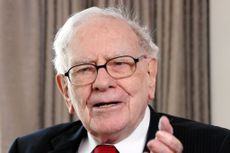Doubling Down on a Falling Stock
Buying more shares makes sense when nothing about a company has changed except the price of its stock.

My friend Al just bought more shares of Westport Innovations (symbol WPRT), a stock in which he had an 85% loss. His logic? “For just a few thousand dollars, I can cut my cost basis in half.” Al was practicing a technique known as averaging down, in which an investor buys more shares after a price decline on the theory that if you like a stock at, say, $40, you’ll love it at $20.
Westport is working on systems to allow trucks to run on natural gas, but fleet owners have yet to find the economics of its offerings compelling. That’s why over the past three years the stock has plunged from $47 to less than $4. In fact, it has fallen 14% since Al bought his additional shares.
Al was averaging down for the wrong reason. Instead of seeing the drop in Westport’s price as a great opportunity for realizing a loss for tax purposes, he was desperate to get even on his investment—and willing to put even more money at risk to do so. If you average down to avoid copping to an investment mistake, you are compounding your error.

Sign up for Kiplinger’s Free E-Newsletters
Profit and prosper with the best of expert advice on investing, taxes, retirement, personal finance and more - straight to your e-mail.
Profit and prosper with the best of expert advice - straight to your e-mail.
Legg Mason’s Bill Miller, the onetime star fund manager, famously said that the investor with the “lowest average cost wins.” But if investing were so simple, we’d all be drowning in money. That’s because companies change, and they don’t always meet investors’ expectations.
Consider Dell, a stock that helped make Miller famous. Dell was a monster performer for years, until competitors figured out its strategy and the growth of the personal-computer business slowed. Then Dell became the classic value trap. In July 2005, it traded at nearly $42. A year later, it was $22. Another year later, it was $29. Then $24. Then $13. Finally, on October 29, 2013, founder Michael Dell took the company private at $13.88 per share. You could have averaged down for eight years and lost a truckload of money, only to have Dell step in and decree, “Game over.”
In truth, sometimes averaging down works, and sometimes it doesn’t. It can work if you’re a really good stock picker or, to lower the bar a bit, simply a good conceptual thinker about stocks. Many of the great value investors—such as Warren Buffett and Marty Whitman, who launched the Third Avenue funds—have said that averaging down is a key strategic tool. Buffett hopes a stock will fall after he starts buying so he can buy more at a cheaper price. Whitman knows a stock is likely to go lower after he starts accumulating it because he usually buys when things look bleakest and he believes that the perception of the company won’t change overnight.
When it works. Averaging down makes sense under two circumstances. Do it when a great company has stumbled, but only if you’re pretty sure that the stumble doesn’t reflect a permanent reversal of fortune. Or average down when nothing about a company has changed except its share price.
I just took the latter approach with Adamis Pharmaceuticals (ADMP), a tiny firm that is seeking approval for new drug-delivery systems for the allergy- and respiratory-medication markets. I paid $5 a share after learning about Adamis in a newsletter. Once I bought, the stock went down relentlessly for nearly three months, eventually hitting $3.82. I bought more at $3.90 per share and a lot more at $4.10. Now my cost basis is $4.60, and the stock is at $5.60 (as of January 9). Just like that, averaging down has turned a tidy gain into an even bigger profit. What a strategic tool!
Of course, the story is far from over. I don’t know how the investment will ultimately turn out, but I am certain that it made sense to buy more shares after the stock had crumbled 24% from my purchase price. I’m confident because the company’s value hadn’t changed, only its share price.

-
 Save Over $40 on Audible With Amazon's Latest Deal
Save Over $40 on Audible With Amazon's Latest DealAmazon’s latest promotion lets you score three months of Audible for just $0.99 a month.
By Erin Bendig Published
-
 Buy eBay and Sell Etsy, Morgan Stanley Says
Buy eBay and Sell Etsy, Morgan Stanley SaysMorgan Stanley is bullish on eBay and bearish on Etsy. Here’s what you need to know.
By Joey Solitro Published
-
 Warren Buffett Stocks: Analyzing The Berkshire Hathaway Portfolio
Warren Buffett Stocks: Analyzing The Berkshire Hathaway PortfolioThe Berkshire Hathaway portfolio is a diverse set of blue chips and some lesser-known growth bets. Here, we look at all stocks picked by Buffett and his lieutenants.
By Dan Burrows Published
-
 6 Best Books on Investing
6 Best Books on Investinginvesting Those looking to build their wealth should consider these best books on investing.
By Coryanne Hicks Published
-
 3 Stocks Warren Buffett Is Buying (and 7 He's Selling)
3 Stocks Warren Buffett Is Buying (and 7 He's Selling)Warren Buffett Warren Buffett upped Berkshire Hathaway's holdings in the oil patch and trimmed its Apple stake, among other moves in Q4.
By Dan Burrows Last updated
-
 Warren Buffett Advice: Why You Should Pick Businesses, Not Stocks
Warren Buffett Advice: Why You Should Pick Businesses, Not StocksCan you beat the averages? Warren Buffett can. What can mere mortals learn from his success?
By James K. Glassman Published
-
 For a Concentrated Stock Position, Ask Your Adviser This
For a Concentrated Stock Position, Ask Your Adviser ThisThere can be advantages to having a lot of stock in one company, but ‘de-risking’ can help avoid some significant disadvantages.
By Robert Gorman Published
-
 5 Stocks to Sell or Avoid Now
5 Stocks to Sell or Avoid Nowstocks to sell In a difficult market like this, weak positions can get even weaker. Wall Street analysts believe these five stocks should be near the front of your sell list.
By Dan Burrows Published
-
 The 9 Best Consumer Staples Stocks to Buy
The 9 Best Consumer Staples Stocks to BuyIn an uncertain market, the best consumer staples stocks provide consistency and stability to portfolios.
By Jeff Reeves Published
-
 Stock Market Today: Hot Inflation Data Sends Stocks Lower
Stock Market Today: Hot Inflation Data Sends Stocks LowerWhile Roku and Cisco Systems got a lift after earnings, Paramount Global didn't fare so well.
By Karee Venema Published